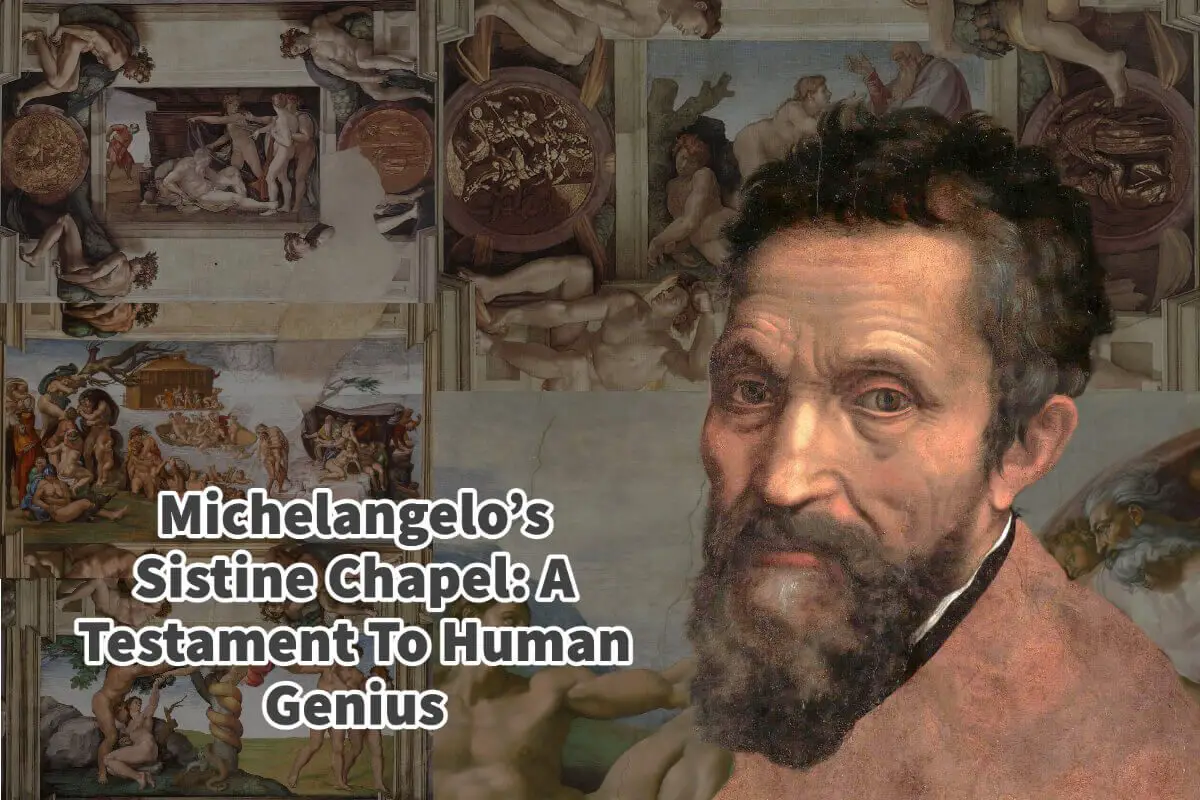Whenever most people think of the Renaissance era of art, one name that comes up as an essential artist is Michelangelo. Michelangelo Buonarroti is considered to be one of the most important and influential artists of the Renaissance era.
Michelangelo’s artistic genius is showcased in the breathtaking frescoes on the ceiling of the Sistine Chapel in Vatican City, Rome. Completed over four years from 1508 to 1512, the Sistine Chapel ceiling is an artistic masterpiece that has captivated the world for centuries.
Table of Contents
- Michelangelo’s Early Life And Artistic Beginnings
- Michelangelo And The Sistine Chapel Ceiling
- How The Sistine Chapel Is A Masterpiece And Genius
- Michelangelo’s Legacy And Influence
- Frequently Asked Questions
- Related Questions
Read on as we explore Michelangelo’s life, artistic style, and why he is considered a testament to human genius.
Michelangelo’s Early Life And Artistic Beginnings
Michelangelo was born in 1475 in Caprese, Italy. He grew up in Florence, where he received his early education in art.

He was trained in the studio of Ghirlandaio, a famous painter at the time. During his early years, Michelangelo focused on sculpture, which became his primary form of artistic expression.
In 1496, Michelangelo created his first sculpture, the “Pieta,” which depicts the Virgin Mary holding the body of Jesus Christ. The sculpture received critical acclaim, and Michelangelo soon became one of the most sought-after artists in Italy.
His fame led him to work for powerful patrons such as the Medici family and Pope Julius II.
Michelangelo And The Sistine Chapel Ceiling
In 1508, Pope Julius II commissioned Michelangelo to paint the ceiling of the Sistine Chapel. Michelangelo initially hesitated to accept the commission, as he considered himself a sculptor rather than a painter.
However, he eventually agreed to take on the challenge, and the result is one of the most iconic works of art in history.
About Michelangelo’s Sistine Chapel Ceiling Painting
The Sistine Chapel ceiling painting is divided into nine panels, each depicting a scene from the Book of Genesis. The centerpiece of the ceiling is the “Creation of Adam,” which portrays God and Adam reaching out to touch each other’s hands.
Michelangelo’s use of color, composition, and perspective created a dynamic and lifelike portrayal of biblical scenes.
The Sistine Chapel ceiling is a masterpiece of Renaissance art, showcasing Michelangelo’s incredible talent and innovative approach. He employed techniques such as foreshortening and chiaroscuro, which created the illusion of depth and movement in his paintings.
Michelangelo’s ability to capture the human form with precision and emotion sets him apart as a genius of his time.
Michelangelo’s Sistine Chapel Shows His Artistic Genius
Michelangelo’s Sistine Chapel ceiling represents human genius and artistic mastery. His ability to create such lifelike and emotional portrayals of biblical scenes using paint is a testament to his immense talent and skill.
Michelangelo’s legacy as one of the greatest artists of all time is secure, and his influence on the art world will continue to be felt for centuries. The Sistine Chapel ceiling remains a timeless masterpiece that will continue to inspire awe and wonder for generations to come.
How The Sistine Chapel Is A Masterpiece And Genius
The Sistine Chapel ceiling is a masterpiece of Renaissance art, and each section of the ceiling displays Michelangelo’s artistic genius in different ways.
Here is a breakdown of each section of the ceiling and why it showcases Michelangelo’s immense talent:

1. Separation of Light from Darkness – The first panel depicts God separating light from darkness, an excellent example of Michelangelo’s mastery of the chiaroscuro technique. The figures are strikingly three-dimensional, with light and shadow used to create a sense of depth and drama.
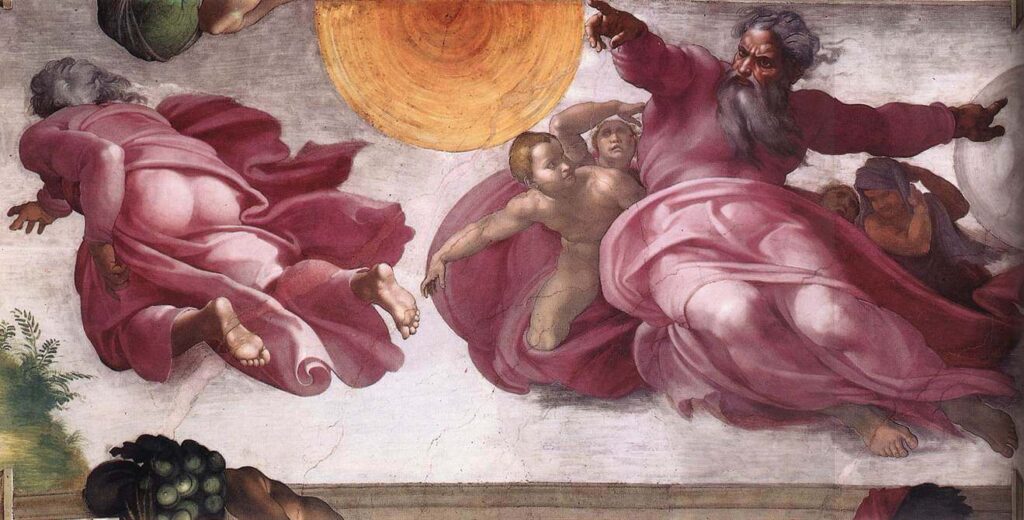
2. The Creation of the Sun, Moon, and Planets – This section showcases Michelangelo’s ability to create intricate and detailed imagery. The celestial bodies are depicted with remarkable accuracy, and their placement within the composition creates a sense of balance and harmony.
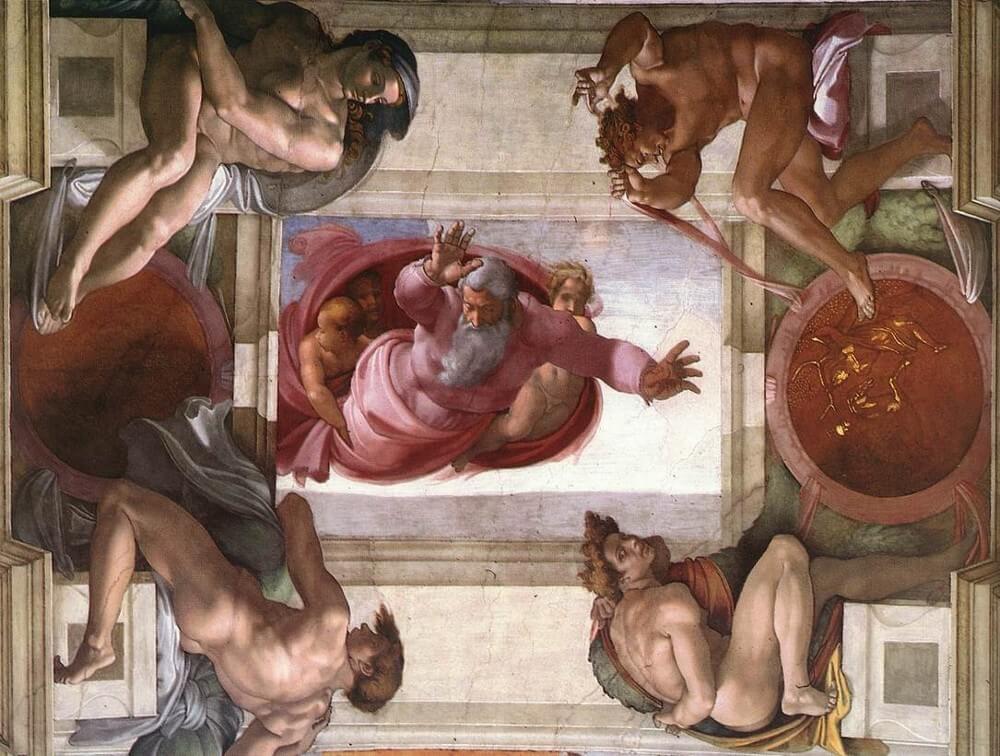
3. The Separation of Land and Water – This panel is a stunning example of Michelangelo’s skill at creating dynamic and expressive figures. The figures are contorted and twisted in a way that creates a sense of tension and movement, and the use of foreshortening makes them seem to burst out of the ceiling.

4. The Creation of Adam – Perhaps the most famous panel on the ceiling, this section showcases Michelangelo’s ability to capture the human form with remarkable precision and emotional depth. The figures of God and Adam are lifelike and full of energy, and foreshortening creates a sense of depth and movement.
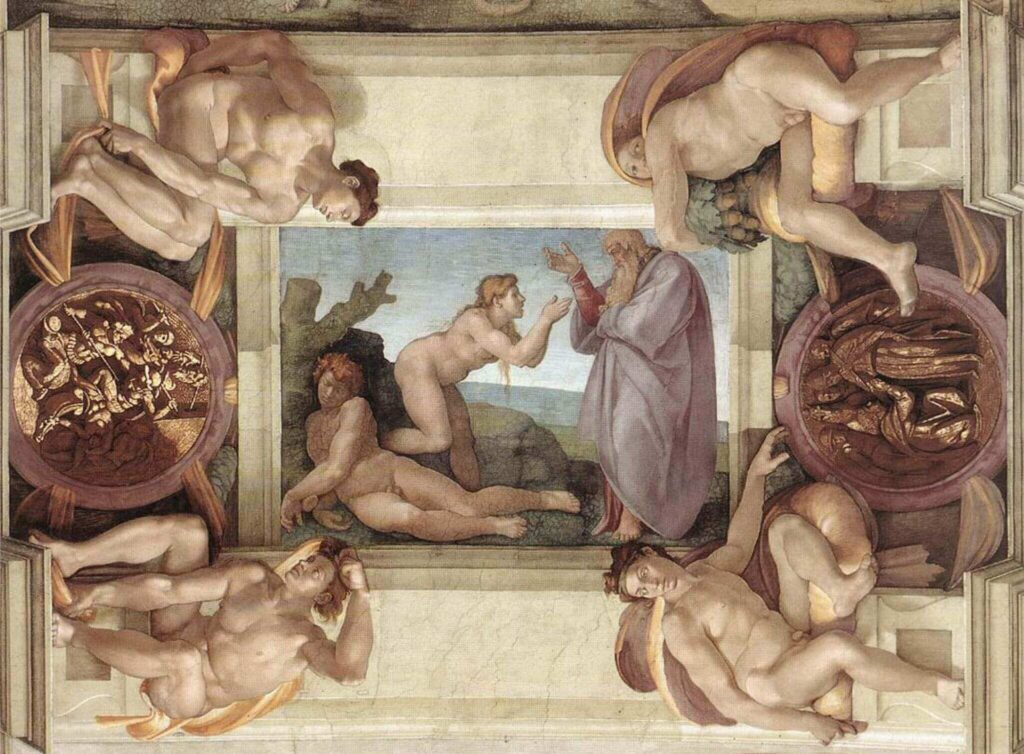
5. The Creation of Eve – In this panel, Michelangelo displays his skill at creating beautiful and delicate figures. The portrayal of Eve is particularly stunning, with her graceful pose and flowing hair creating a sense of elegance and beauty.
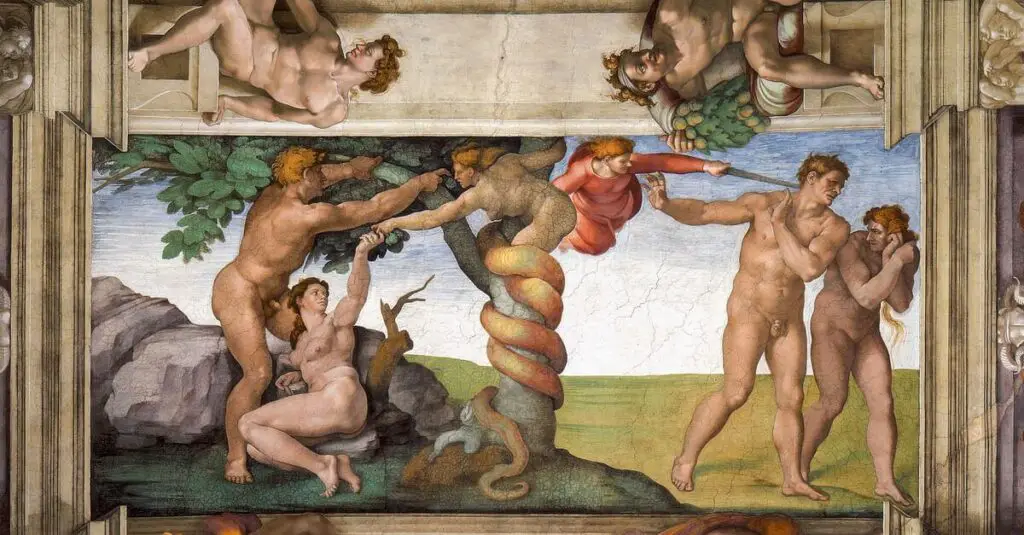
6. The Temptation and Expulsion from the Garden of Eden – This section is a testament to Michelangelo’s ability to create powerful and dramatic imagery. The figures of Adam and Eve are wracked with emotion and turmoil, and the twisting serpent adds a sense of danger and menace to the scene.
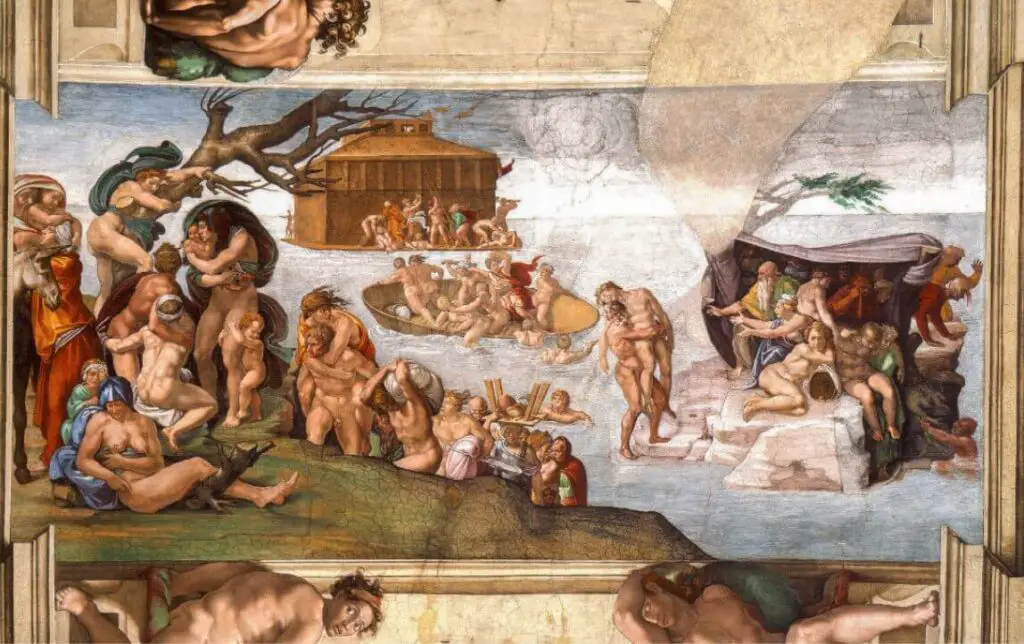
7. The Flood – This panel showcases Michelangelo’s talent for creating large-scale compositions with remarkable detail. The numerous figures are depicted with incredible precision, and perspective creates a sense of depth and grandeur.
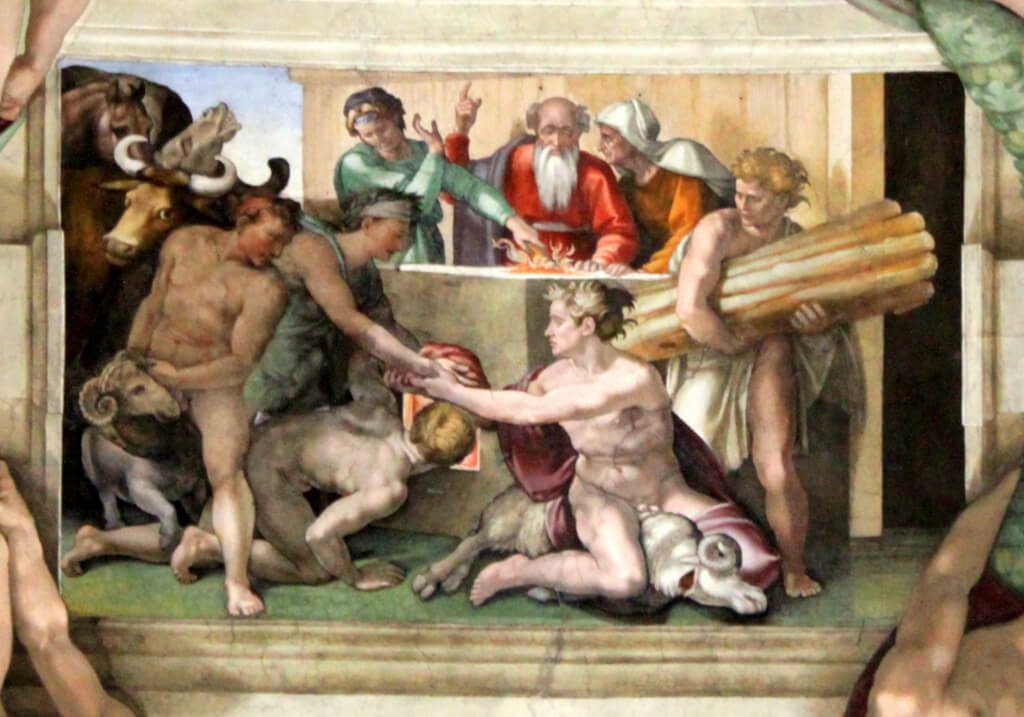
8. The Sacrifice of Noah – This section displays Michelangelo’s skill at creating highly emotive figures. The figure of Noah is full of anguish and sorrow, while the figures of the animals are expressive and full of life.
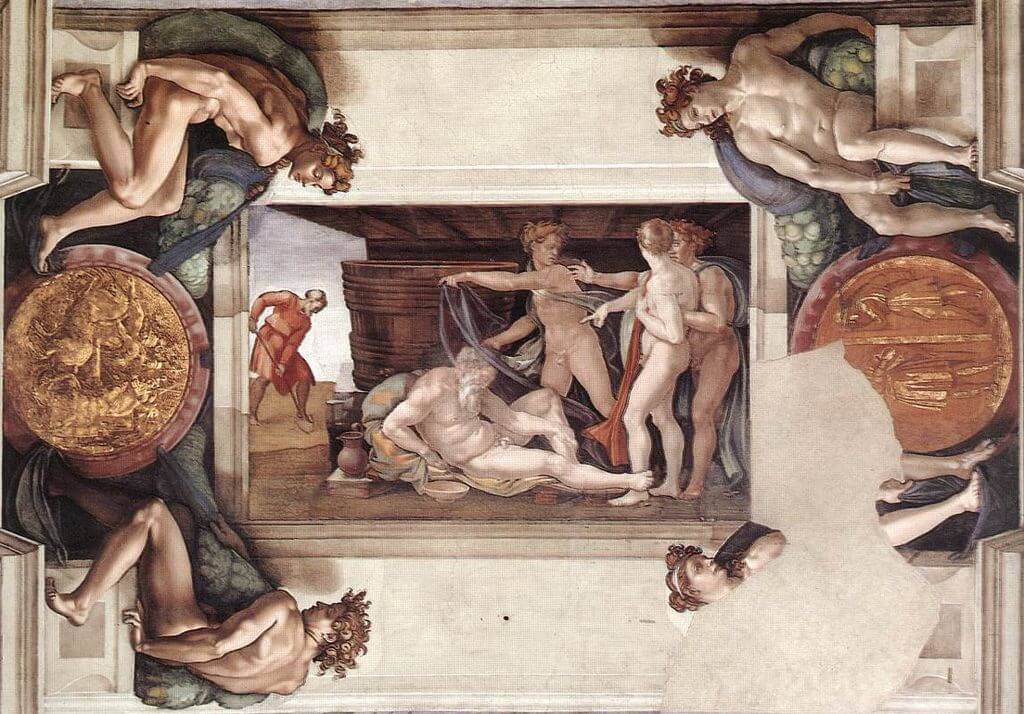
9. The Drunkenness of Noah – This final panel is a testament to Michelangelo’s sense of humor and playfulness. The figure of a drunken Noah is highly expressive and exaggerated, adding a sense of fun and whimsy to the otherwise severe and somber ceiling.
What makes this work of art artistic genius is that section of the Sistine Chapel ceiling showcases Michelangelo’s immense artistic talent in different ways. From his mastery of chiaroscuro and foreshortening to his ability to capture the human form with precision and emotion,
Michelangelo’s genius is genuinely on full display throughout the entire Sistine Ceiling.
Michelangelo’s Legacy And Influence
Michelangelo’s influence on the art world is immeasurable. His works have inspired countless artists over the centuries, and his legacy continues today.
He is considered a pioneer of the Renaissance style, emphasizing a return to classical values and individualism.
Michelangelo’s works are characterized by their realism, emotion, and attention to detail. He had a unique ability to capture the human form with precision and expressiveness, making his works come alive.
His influence on the art world can still be seen today, with artists drawing inspiration from his style and techniques. That is why Michelangelo earns a place as one of the greatest artists that ever lived and a genius in executing the art of the Sistine Chapel.
Anita Louise Art is dedicated to art education, great artists, and inspiring others to find and create their art. We love art that uplifts and inspires. #ArtToMakeYouSmile! #ArtToMakeYouHappy!
If you are interested to see any of my art, you can find out more by clicking here. If you are interested in what inspires me and my paintings, you can discover more by clicking here.
We have a free newsletter and would love you to be part of our community; you can subscribe to the newsletter by clicking here. If you have any questions, I would be happy to talk to you. You can reach me, Anita, by clicking here.
Join us for our podcast “5 Minutes With Art.” Spend just 5 minutes a week with us to discover and learn about great art and artists. You can find out more about our podcast by clicking here.
Frequently Asked Questions
What is the Sistine Chapel, and where is it located?
The Sistine Chapel is a renowned chapel located in Vatican City, Rome. It is part of the Apostolic Palace and serves as the official residence of the Pope. Michelangelo’s masterpiece, the frescoes on the ceiling, is a focal point of this chapel.
What inspired Michelangelo to create the frescoes on the Sistine Chapel ceiling?
Michelangelo was commissioned by Pope Julius II to paint the ceiling of the Sistine Chapel. The inspiration behind the artwork draws from various biblical themes, emphasizing the creation of man, the fall, and other narratives from the Book of Genesis.
How long did it take Michelangelo to complete the Sistine Chapel ceiling?
Michelangelo spent four years, from 1508 to 1512, working tirelessly on the Sistine Chapel ceiling. Despite the challenging conditions and the physical strain on the artist, the result is considered a testament to his unparalleled artistic skill.
What techniques did Michelangelo employ in creating the frescoes?
Michelangelo used fresco painting, a technique involving the application of pigments on wet plaster. This method required precision and speed, as the artist had to work before the plaster dried. The intricate details and vibrant colors of the Sistine Chapel ceiling attest to Michelangelo’s mastery of this technique.
How many individual scenes or panels are depicted on the Sistine Chapel ceiling?
The Sistine Chapel ceiling comprises a total of nine panels, each portraying different biblical scenes. Notable among these are the iconic “Creation of Adam” and “The Last Judgment.”
What is the significance of the “Creation of Adam” panel on the Sistine Chapel ceiling?
The “Creation of Adam” is one of the most famous panels on the ceiling, depicting the moment when God gives life to Adam. The composition, with the outstretched hands of God and Adam, has become an iconic representation of human creation and divine connection.
Did Michelangelo face any challenges while working on the Sistine Chapel ceiling?
Working on the ceiling posed numerous challenges for Michelangelo, including physical discomfort due to the ceiling’s height and the demanding nature of fresco painting. Additionally, he had to overcome the limitations of the space and work against the effects of gravity.
How did Michelangelo’s Sistine Chapel ceiling impact the perception of art during the Renaissance?
Michelangelo’s work on the Sistine Chapel ceiling is considered a pinnacle of Renaissance art. It set new standards for artistic achievement, showcasing the potential of human creativity and skill. The ceiling’s influence extended beyond its time, inspiring generations of artists.
Has the Sistine Chapel ceiling undergone any restoration work?
Yes, the Sistine Chapel ceiling has undergone multiple restoration efforts. The most notable was the extensive restoration completed in the 1980s, addressing issues such as discoloration and damage caused by centuries of candle smoke and environmental factors.
Can visitors still view Michelangelo’s Sistine Chapel ceiling today?
Yes, the Sistine Chapel is open to the public, and visitors can marvel at Michelangelo’s masterpiece. However, due to the fragility of the artwork, there are restrictions on photography and visitors are reminded to maintain a respectful and quiet atmosphere within the chapel.
Related Questions
Did Michelangelo And Leonardo Know Each Other?
Michelangelo and Leonardo da Vinci knew each other but were considered bitter rivals. Leonardo da Vinci and Michelangelo knew each other, but they did like each other. They were both asked to do a commission on the Council Hall of the Palazzo Vecchio and were supposed to work side-by-side; the project was never completed.
By clicking here, you can learn more by reading Did Michelangelo And Leonardo Know Each Other?.
Michelangelo’s Method To Paint The Sistine Chapel Ceiling
He built a large scaffolding structure that could move around the chapel to paint the ceiling; the painting of the Sistine Chapel was an extremely strenuous work that was a huge personal cost both physically and mentally to Michelangelo.
By clicking here, you can learn more by reading Michelangelo’s Method To Paint The Sistine Chapel Ceiling.
Michelangelo’s Sistine Chapel And His Payment
Michelangelo was paid 3200 gold ducats for his work on the ceiling of the Sistine Chapel, which would have been a very lucrative commission. We know that he stopped work on the ceiling for a while due to his not being paid by the Vatican. Michelangelo liked to give the impression that he was a very poor artist, but records have shown that he died an extremely wealthy man.
By clicking here, you can learn more by reading Michelangelo’s Sistine Chapel And His Payment.

